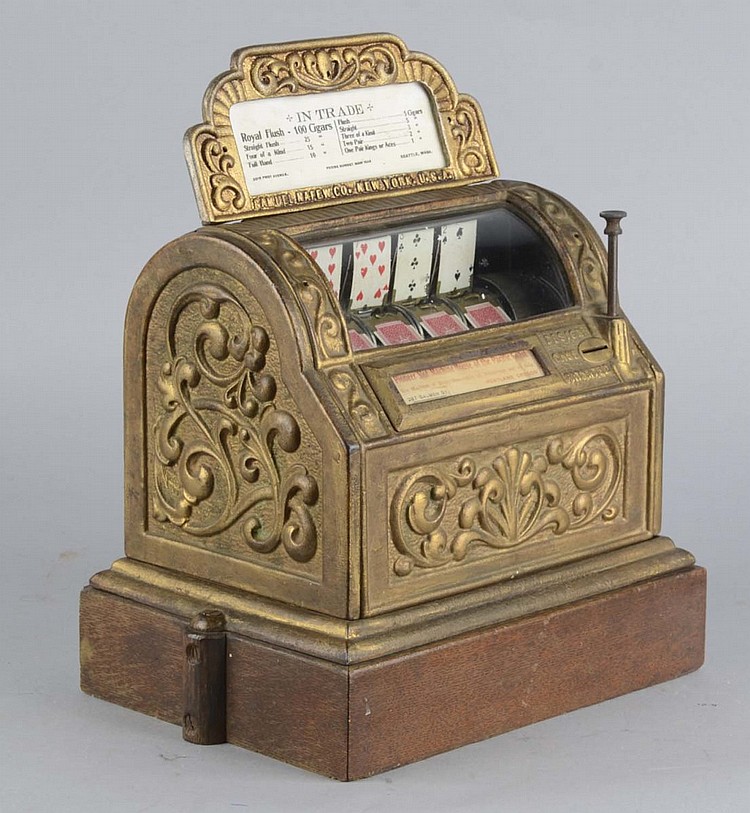First Mechanical Slot Machine
The term slot machine (short for nickel-in-the-slot machine) was originally also used for automatic vending machines but in the 20th century came to refer almost exclusively to gambling devices.
- Illinois Video Gaming Slot Machines
- Slot Machines For Fun Only
- Name Of First Mechanical Slot Machine Bell
- Best Time To Play Slot Machines

Introduction
- For instance, the first ever slot machine, The Liberty Bell, was invented in 1895 as a way of entertaining San Francisco saloon customers. Lining up three Liberty Bells was enough to pay out the big jackpot: 10 nickels, or $0.50.
- World's First Slot Machine Payline. Somewhere between 1885 and 1897, Californian car mechanic Charles Fey invented the first mechanical slot machine, which featured 4 symbols on 3 reels. This was known as the 'Liberty Bell' and in order to win the highest payout (10 nickels), the player had to get three bells in a row.

History
Herbert S. Mills further perpetuated the popularity of the Bell machines. By increasing the reliability and decreasing the cost of manufacturing slots, Mills was able to ship these machines throughout the new territories of the United States. He also pioneered the inclusion of a pack of gum with play in order to skirt the growing number of laws restricting the use of these gambling attractions. In essence, gamblers could only play once they performed the legal transaction of “buying” the gum. In 1906, Mills introduced his own slot machine with the now-classic bell and other symbols (Fig. 1) supplanting the original card signs on the slot reels [2]. Furthermore, he expanded the window opening from one to three lines to add another factor to entice people to play, as players could now see how close they were to winning.
Illinois Video Gaming Slot Machines
The Modern Electronic Reel Slot Machine: A Piece by Piece Breakdown
To simplify the thousands of combinations into discrete slots on reels, each random number in the combination is divided by a set value (typically, slot machines use 32, 64, 128, 256, or 512 as that value). The computer records the remainder of this quotient, which by mathematical law cannot exceed the set value [4]. The remainder is mapped to a certain symbol that is physically distributed among the number of slots the reel contains. A virtual representation of this mapping using a set value of 128 and a reel with 22 slots may be seen in Fig. 2.
For a machine with actual spinning reels, once the random numbers have been generated, the machine uses a stepper motor to turn each reel and stop it at the predetermined point [4]. A stepper motor is an electromechanical device that uses electrical pulses to drive a shaft or spindle in discrete increments. These incremental movements are related to the frequency and sequence of the electrical pulses, allowing for total movement control [6]. If the machine only has a screen, then a piece of software animates a virtual spinning reel.
Slot-Machine Innovations
One of the most intriguing developments in slot technology involves connecting slots to servers, much as office computer networks are designed. This innovation would allow casinos to easily manage minimum bets, percentages paid, and the type of game available on a machine. Furthermore, these activities or factors could be adjusted based on the time of day, level of activity at each floor, or even the players’ personal information [8]. These networks will also allow different games to be recommended for different players as well as the streaming of live television to built-in screens.
Slot Machines For Fun Only
Name Of First Mechanical Slot Machine Bell
References
Best Time To Play Slot Machines
- [1] “Nevada Reporting Huge Casino Profits.” Online Gambling Paper. n.d. Web. 16 Jul. 2010. <http://www.ogpaper.com/news/news-0222.html>.
- [2] Jack Kelly. “Slots: Perfecting a machine to take away your money.” American Heritage of Invention and Technology-Online 16.2 (2000): 34. Web. 13 Jul. 2010.
- [3] Michael Bluejay. “How Slot Machines Work.” Top Ten Las Vegas Tips. n.d. Web. 16 Jul. 2010. <http://vegasclick.com/games/slots/how-they-work.html>.
- [4] Tom Harris. “How Slot Machines Work.” HowStuffWorks. 26 Feb. 2002. Web. 15 Jul. 2010.<http://entertainment.howstuffworks.com/slot-machine.htm>.
- [5] Haruo Inoue. 1997. Slot Machine. U.S. Patent 5,609,524, filed July 12. 1995, and issued March 11, 1997.
- [6] “Stepper Motors.” Omega Engineering Web. 16 July 2010. <http://www.omega.com/prodinfo/stepper_motors.html>.
- [7] Christopher Palmeri. “Face-lift for the One-Armed Bandit.” Business Week 21 Dec. 2009: 77. Web. 15 July 2010. <http://www.thefreelibrary.com/FACE-LIFT+FOR+THE+ONE-ARMED+BANDIT-a01612094149>.
- [8] Quentin Hardy. “Well-Armed Bandits – Forbes.com.” Forbes Business News. 19 May 2008. Web. 16 Jul. 2010. <http://www.forbes.com/global/2008/0519/054.html>.
- [9] “Old Downtown Las Vegas History.” EarlyVegas. n.d. Web. 20 Jul. 2010. <http://www.earlyvegas.com/downtown.html>.
- [10] Rusman. “Playing in an Online Slot Machines for Players.” Games and Entertainment Reviews. 6 Aug. 20101. Web. 11 Oct. 2010. <http://www.komiks-dk.net/slot-machines/playing-in-an-online-slot-machines-for-players.html>.